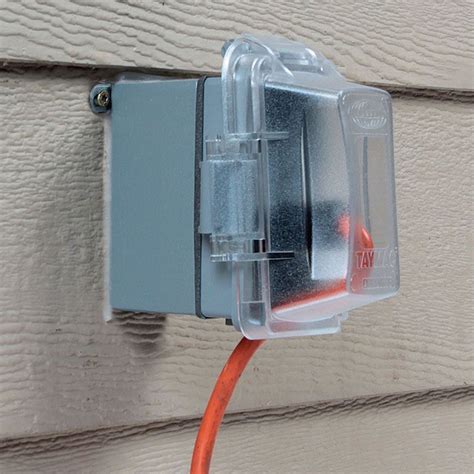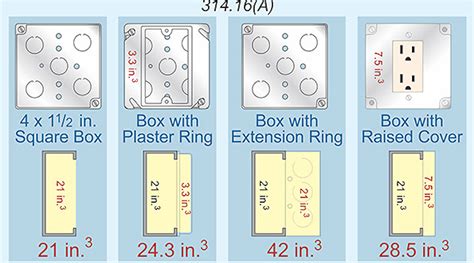electrical wire box size One of the mistakes often made is over loading an wire electrical box with too many wires. This will cause switches and outlets to not fit correctly and could even cause wires to become damaged. This information will help you plan . In this blog post, we will delve into the different types of sensors used in CNC machines, their functionalities, and their applications. 1. Proximity Sensors:\ Proximity sensors are commonly .
0 · types of outdoor electrical boxes
1 · types of electrical panel boxes
2 · standard electrical box sizes
3 · size of electrical outlet box
4 · electrical pull box size chart
5 · electrical box size charts
6 · electrical box size calculator
7 · all types of electrical boxes
Box plots and whisker diagrams are great for showing data distribution. They’re useful for comparing groups or samples. These plots summarize the data, highlighting the median, .
One of the mistakes often made is over loading an wire electrical box with too many wires. This will cause switches and outlets to not fit correctly and could even cause wires to become damaged. This information will help you plan . Use 314.28(A) to size pull boxes, junction boxes, and conduit bodies when using conductor sizes 4 AWG and larger. Suppose you have a 2-inch raceway coming into a 10-inch square box, and a 2-inch raceway leaves it on . The American Wire Gauge (AWG) system provides standard wire gauge sizes. The higher the number of the gauge, the smaller the size of the wire. See the AWG chart below for examples. The National Electrical Code (NEC) . Wires, receptacles and switches need adequate space. Crowded boxes can damage wires, resulting in a fire or shock hazard. You can use the chart below to calculate the .
According to the 2020 NEC®, we should count one volume allowance for each conducting wire entering or passing through an electrical box regardless of their wire sizes. You can use our wire size calculator if you want .Here we describe matching 15-Amp receptacles to 15-Amp circuits, 20-Amp receptacles to 20-Amp circuits, two-wire receptacles where no ground is present, GFCI and AFCI electrical receptacles, and the proper electrical box to hold . Electrical boxes encase wire connections to protect them from short circuits. They are vital for fire safety and are used for receptacles, ceiling fans, outside outlets, and more. Unless the device is one of the few that . To determine if an electrical box has enough volume for your wiring project, you need to calculate how much volume each wire and device takes up inside the box. The NEC provides a table (Table 314.16(A)) that lists .
A single-gang box 3 1⁄2 in. deep has a capacity of roughly 22 1⁄2 cu. in., enough space for a single device (receptacle or switch), three 12–2 w/grd cables, and two wire connectors. Double-gang boxes hold two devices; triple-gang boxes hold . The National Electrical Code has published a chart that determines a junction box’s correct size, based on the number and size of the conductors it must accommodate. The size of a conductor is expressed as AWG (American .One of the mistakes often made is over loading an wire electrical box with too many wires. This will cause switches and outlets to not fit correctly and could even cause wires to become damaged. This information will help you plan your electrical box size properly.
Use 314.28(A) to size pull boxes, junction boxes, and conduit bodies when using conductor sizes 4 AWG and larger. Suppose you have a 2-inch raceway coming into a 10-inch square box, and a 2-inch raceway leaves it on the opposite side. The American Wire Gauge (AWG) system provides standard wire gauge sizes. The higher the number of the gauge, the smaller the size of the wire. See the AWG chart below for examples. The National Electrical Code (NEC) mandates the regulations for wire and cable that can be used for electrical applications. Key Definitions Wires, receptacles and switches need adequate space. Crowded boxes can damage wires, resulting in a fire or shock hazard. You can use the chart below to calculate the required box size. Add up the numbers for the correspond- ing components in the box to find how many cubic inches you’ll need.
According to the 2020 NEC®, we should count one volume allowance for each conducting wire entering or passing through an electrical box regardless of their wire sizes. You can use our wire size calculator if you want to learn how certified electricians choose the right wire size for a particular application.Here we describe matching 15-Amp receptacles to 15-Amp circuits, 20-Amp receptacles to 20-Amp circuits, two-wire receptacles where no ground is present, GFCI and AFCI electrical receptacles, and the proper electrical box to hold and mount these devices. Electrical boxes encase wire connections to protect them from short circuits. They are vital for fire safety and are used for receptacles, ceiling fans, outside outlets, and more. Unless the device is one of the few that contains its own wires, it likely will need an electrical box. To determine if an electrical box has enough volume for your wiring project, you need to calculate how much volume each wire and device takes up inside the box. The NEC provides a table (Table 314.16(A)) that lists how much volume each wire size requires based on its type (solid or stranded) and insulation (THHN/THWN-2/T90).

types of outdoor electrical boxes
A single-gang box 3 1⁄2 in. deep has a capacity of roughly 22 1⁄2 cu. in., enough space for a single device (receptacle or switch), three 12–2 w/grd cables, and two wire connectors. Double-gang boxes hold two devices; triple-gang boxes hold three devices. The National Electrical Code has published a chart that determines a junction box’s correct size, based on the number and size of the conductors it must accommodate. The size of a conductor is expressed as AWG (American Wire Gauge); the .One of the mistakes often made is over loading an wire electrical box with too many wires. This will cause switches and outlets to not fit correctly and could even cause wires to become damaged. This information will help you plan your electrical box size properly. Use 314.28(A) to size pull boxes, junction boxes, and conduit bodies when using conductor sizes 4 AWG and larger. Suppose you have a 2-inch raceway coming into a 10-inch square box, and a 2-inch raceway leaves it on the opposite side.
The American Wire Gauge (AWG) system provides standard wire gauge sizes. The higher the number of the gauge, the smaller the size of the wire. See the AWG chart below for examples. The National Electrical Code (NEC) mandates the regulations for wire and cable that can be used for electrical applications. Key Definitions
Wires, receptacles and switches need adequate space. Crowded boxes can damage wires, resulting in a fire or shock hazard. You can use the chart below to calculate the required box size. Add up the numbers for the correspond- ing components in the box to find how many cubic inches you’ll need.
According to the 2020 NEC®, we should count one volume allowance for each conducting wire entering or passing through an electrical box regardless of their wire sizes. You can use our wire size calculator if you want to learn how certified electricians choose the right wire size for a particular application.Here we describe matching 15-Amp receptacles to 15-Amp circuits, 20-Amp receptacles to 20-Amp circuits, two-wire receptacles where no ground is present, GFCI and AFCI electrical receptacles, and the proper electrical box to hold and mount these devices.
Electrical boxes encase wire connections to protect them from short circuits. They are vital for fire safety and are used for receptacles, ceiling fans, outside outlets, and more. Unless the device is one of the few that contains its own wires, it likely will need an electrical box. To determine if an electrical box has enough volume for your wiring project, you need to calculate how much volume each wire and device takes up inside the box. The NEC provides a table (Table 314.16(A)) that lists how much volume each wire size requires based on its type (solid or stranded) and insulation (THHN/THWN-2/T90).

A single-gang box 3 1⁄2 in. deep has a capacity of roughly 22 1⁄2 cu. in., enough space for a single device (receptacle or switch), three 12–2 w/grd cables, and two wire connectors. Double-gang boxes hold two devices; triple-gang boxes hold three devices.

cnc shark hd4 parts

types of electrical panel boxes
Metal roof sheets provide durable, energy-efficient, and low-maintenance protection. Most of these roofs are commonly made using metals like aluminum, steel, or copper. They .
electrical wire box size|all types of electrical boxes